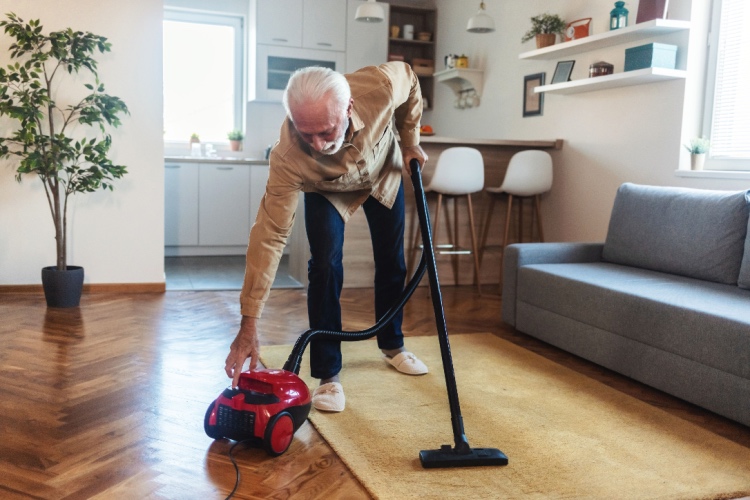
Home has always been a place of comfort, but as people spend more time indoors later in life, the home environment begins to play a bigger role in emotional wellness. Studies show that surroundings can influence how calm, motivated, and engaged a person feels.
A peaceful environment doesn’t have to mean a perfectly decorated home, it means a space that feels manageable, welcoming, and aligned with your lifestyle. Whether you live alone, with family, or in an assisted setting, the way your home feels can shape your mood and even your sense of independence.
Table of Contents
- Clutter, Clarity, and the Mind
- How Light, Color, and Air Quality Affect Mood
- Creating Comfort and Accessibility for Daily Peace
- The Emotional Power of Belongings and Memories
- Building a Home That Encourages Connection
- Small Adjustments That Can Lift Your Mood
- When Home Maintenance or Change Feels Overwhelming
- Emotional Support for Seniors in Changing Home Environments
- Rediscovering Calm and Balance with Blue Moon Senior Counseling
Clutter, Clarity, and the Mind
Clutter is more than just visual noise, it can quietly add tension to your day. For many seniors, accumulated belongings represent years of memories, responsibilities, and habits. Yet, too many objects in sight can make it harder to focus or relax.
According to research from Princeton University and UCLA, clutter competes for your attention and can lead to higher stress levels. That doesn’t mean everything has to be spotless. It’s about finding a balance between meaningful possessions and the freedom of open space.
Here are a few realistic ways to approach it:
- Start small. Focus on one area, such as a drawer or table, rather than the entire home.
- Keep what serves your daily life. Items you use or that make you happy deserve space; others can be stored, donated, or gifted.
- Simplify visibility. Clear countertops and open walkways help your mind feel less crowded too.
For seniors with limited mobility, it’s also important to ensure that frequently used items are easy to reach and that pathways are open. This not only helps prevent falls but also makes moving around your home feel more natural and less frustrating.
Over time, a decluttered home becomes a calmer one. The fewer obstacles you see, the fewer you feel internally.
How Light, Color, and Air Quality Affect Mood
Light and air have invisible but powerful effects on emotional health. Sunlight, in particular, supports the body’s natural rhythm by helping regulate sleep and boosting vitamin D, which contributes to mood balance.
If a home is dimly lit or always has closed blinds, it can begin to feel isolating. Bringing in more natural light during the day or using soft lighting in the evening can help you stay alert yet relaxed. Try positioning a favorite chair near a window for reading or morning coffee, it can do wonders for your energy levels.
Color also matters. Pale blues and greens are known to create a calming atmosphere, while earth tones add warmth. Bright colors in moderation can bring cheer to certain spaces like kitchens or creative areas. The goal is not perfection in design but creating surroundings that help you feel at ease.
Lastly, air quality deserves attention. Dust, pet dander, and poor ventilation can cause headaches or fatigue over time. Regularly cleaning vents, opening windows when weather allows, or using a small air purifier can improve how you feel physically and emotionally. Clean air and light-filled spaces often make daily living more enjoyable and less draining.
Creating Comfort and Accessibility for Daily Peace
As bodies change with age, so should the spaces people live in. A home designed for comfort and safety can greatly reduce anxiety and frustration.
Practical adjustments don’t have to be major renovations. Even small updates can help you feel more confident at home. Examples include:
- Non-slip mats in bathrooms and kitchens
- Grab bars in hallways or near the shower
- Chairs or benches for resting while cooking or dressing
- Bedside lighting that’s easy to reach
Accessibility brings peace of mind. When movement through the home is easy, it lowers stress and supports independence.
Emotional comfort is equally important. Familiar furniture, soothing sounds, or treasured family items can make a space feel personal and safe. Combining functionality with familiarity helps create a home that supports both physical and emotional well-being.
The Emotional Power of Belongings and Memories
Belongings carry meaning, especially as people grow older and their homes become reflections of their life stories. Every keepsake, photograph, or memento has a memory attached. But when too many items accumulate, they can shift from comforting to overwhelming.
It’s common for seniors to struggle with deciding what to keep and what to pass on. This is not simply about tidying up, it’s an emotional process tied to identity and history. Taking time to sort through items at your own pace, and perhaps sharing the experience with family, can make it more positive.
Here are gentle approaches that can help:
- Preserve memories without excess. Take photos of meaningful items before donating or gifting them.
- Create a memory display. Dedicate one small space, like a shelf or wall, for your favorite items instead of spreading them throughout the house.
- Share stories. Passing items to loved ones with a story attached keeps their meaning alive.
These choices can help free space while strengthening the connection to family and personal history. Letting go of clutter doesn’t mean letting go of memories, it often means finding a more peaceful way to honor them.
Building a Home That Encourages Connection
A home is more than its walls; it’s also a gateway to relationships. Social interaction plays a crucial role in mental health, especially for seniors who may spend more time at home. Loneliness can contribute to sadness and anxiety, while connection promotes resilience and happiness.
Simple layout choices can encourage togetherness. Arranging furniture for easy conversation, setting up a small table for card games, or keeping a comfortable chair near the phone can make reaching out to others easier.
Technology can also bridge gaps. Tablets or computers placed in accessible spots allow video calls, online classes, or group chats to become part of the daily routine. Having a space that supports these connections helps maintain engagement with loved ones and the community, even from home.
Decor, too, can play a part. Displaying family photos or reminders of shared experiences can reinforce feelings of belonging. The goal is not just a home that looks nice, but one that helps you feel connected and emotionally supported.
Small Adjustments That Can Lift Your Mood
Mental wellness often thrives on small, consistent habits, and your home can help support those habits. Small environmental adjustments can shift how you feel throughout the day without much effort.
Consider these ideas:
- Incorporate nature. Plants, flowers, or even scenic artwork can improve mood and reduce stress.
- Play with sound. Calming background music or gentle sounds like rain or waves can promote relaxation.
- Focus on comfort. Soft textures, blankets, or warm lighting can make evenings more soothing.
- Keep routines visible. Use notes, calendars, or visible reminders for daily goals to encourage consistency.
Even subtle changes, such as setting up a comfortable reading corner or organizing medication supplies neatly, can foster a sense of control and peace. Over time, these small efforts can have lasting positive effects on emotional well-being.
When Home Maintenance or Change Feels Overwhelming
There may come a time when managing your home begins to feel like a challenge. Tasks that were once simple, laundry, cleaning, or organizing, might start to feel tiring or unmanageable. It’s important to recognize that this feeling is common and not a reflection of personal failure.
When this happens, seeking help can make a significant difference. Options include asking family for assistance, hiring light housekeeping support, or connecting with local volunteer organizations. The goal is to make your home more manageable, not perfect.
In some cases, seniors may consider downsizing or moving to a space that better fits their current needs. This transition can bring mixed emotions, especially when leaving a long-time home. Taking time to adjust, bringing personal items, and creating a familiar atmosphere in the new space can help maintain emotional stability through the change.
Feeling in control of these choices, rather than rushed or pressured, often leads to a smoother and more positive experience.
Emotional Support for Seniors in Changing Home Environments
Changes to the home, whether by choice or necessity, can stir complex emotions. Seniors may feel nostalgic, uncertain, or anxious about how these shifts will affect their independence and comfort. It’s completely natural to experience a range of emotions during these transitions.
Professional counseling offers a safe space to talk through those feelings, explore coping strategies, and regain confidence. Emotional support helps identify what truly contributes to peace of mind and helps navigate challenges with clarity.
At Blue Moon Senior Counseling, our licensed therapists understand the emotional aspects of change later in life. We provide guidance tailored to each person’s circumstances, focusing on practical ways to strengthen emotional resilience and daily satisfaction. Counseling isn’t just about mental health, it’s about improving quality of life and helping individuals feel supported in every environment they call home.
Rediscovering Calm and Balance with Blue Moon Senior Counseling
A home should be more than a physical shelter, it should feel like a source of calm and stability. If your home environment no longer feels that way, it may be time to focus on both your surroundings and your emotional well-being.
Your home can become a place that nurtures your spirit again. Reach out to Blue Moon Senior Counseling today to learn how emotional support can help you find balance, comfort, and renewed peace at home.
Frequently Asked Questions
- How can I tell if my home is affecting my mental health?
If you notice frequent stress, fatigue, or restlessness when spending time at home, your surroundings may be playing a role. Light, clutter, and layout all contribute to how relaxed or tense you feel. Making small adjustments often provides clarity about what’s helping or hurting your mood. - What can I do if my home feels too cluttered but I don’t know where to start?
Begin with one manageable area. Sort items into keep, donate, or discard piles. Ask family or friends for help if needed. Taking small steps instead of tackling everything at once helps make the process less overwhelming. - Does rearranging my home really improve my emotional well-being?
Yes, even small layout changes can have a positive effect. Moving furniture for easier mobility, increasing natural light, or creating cozy spaces can improve comfort and calmness without major effort. - How do I handle emotional attachment to my belongings when decluttering?
It helps to recognize that the memories live within you, not only in the items themselves. Taking photos, sharing items with loved ones, or creating a small memory space can help preserve their meaning without feeling crowded. - 5. How can Blue Moon Senior Counseling help me if I’m struggling emotionally at home?
Our licensed therapists specialize in helping seniors navigate emotional challenges that may arise from changes in lifestyle, health, or home environments. We focus on practical tools for coping, emotional resilience, and improving your overall sense of well-being.
